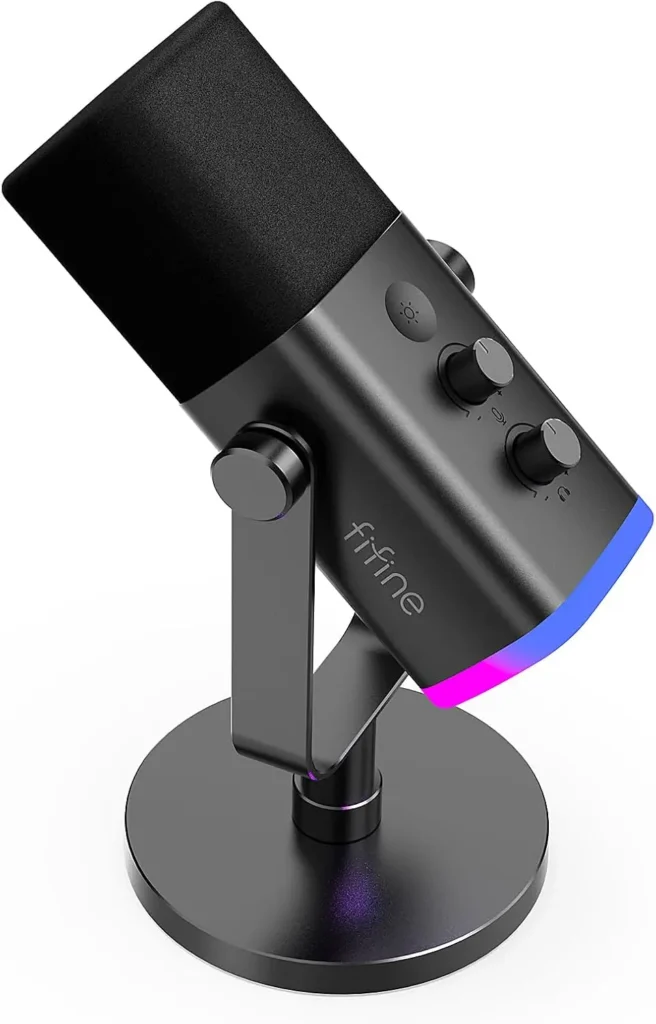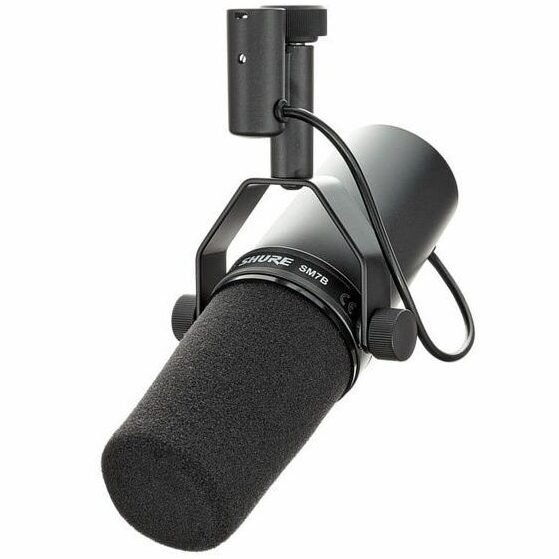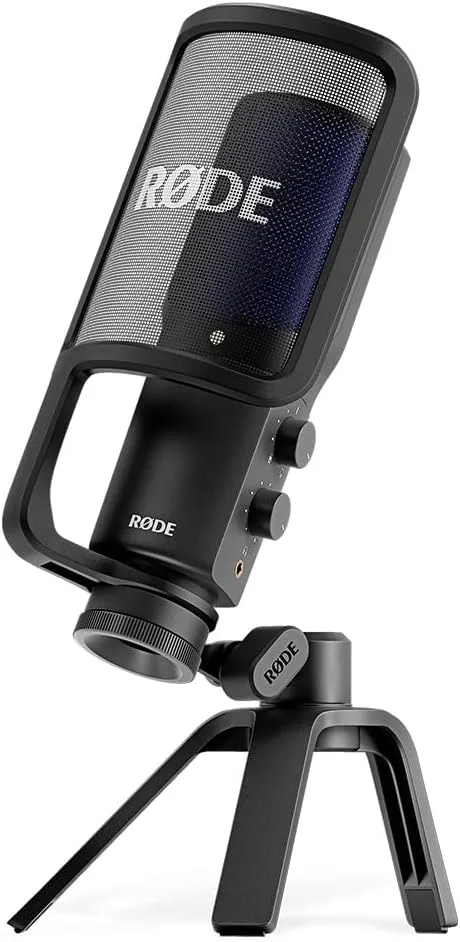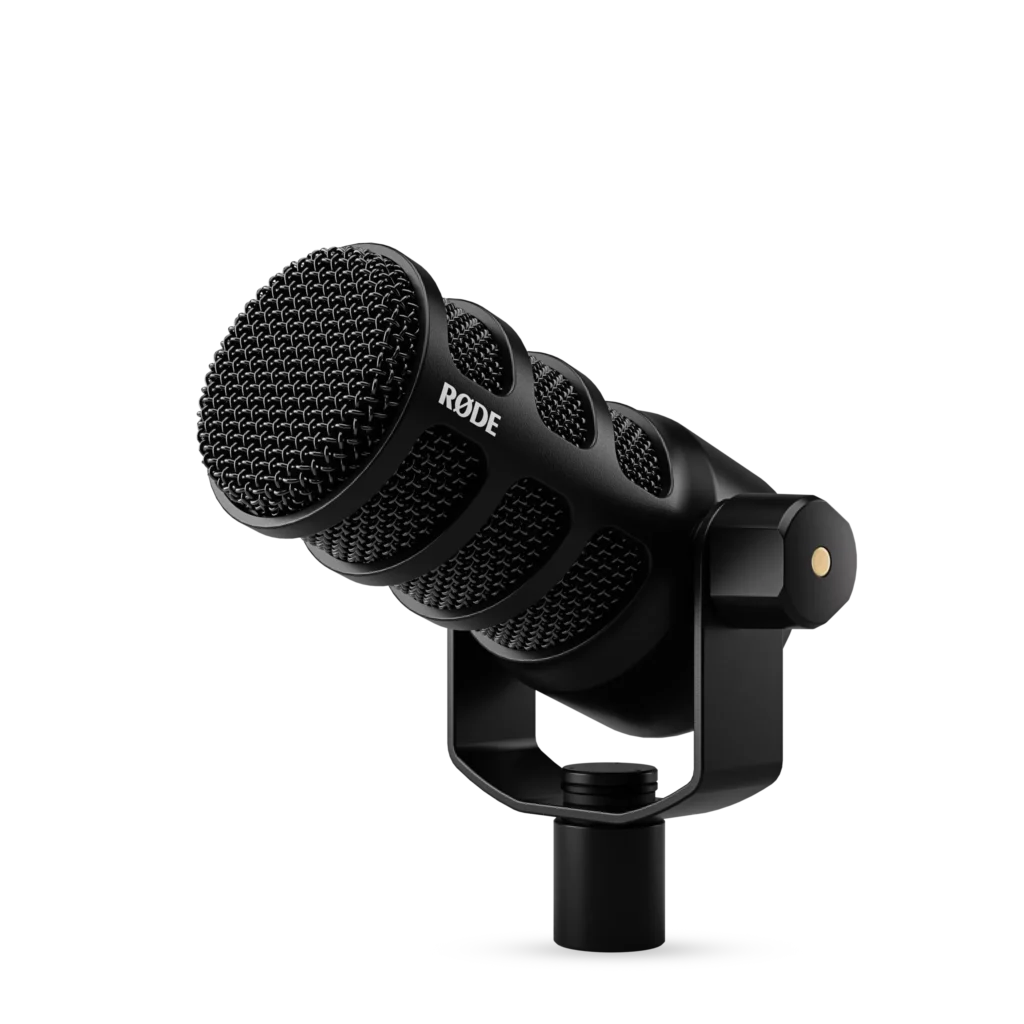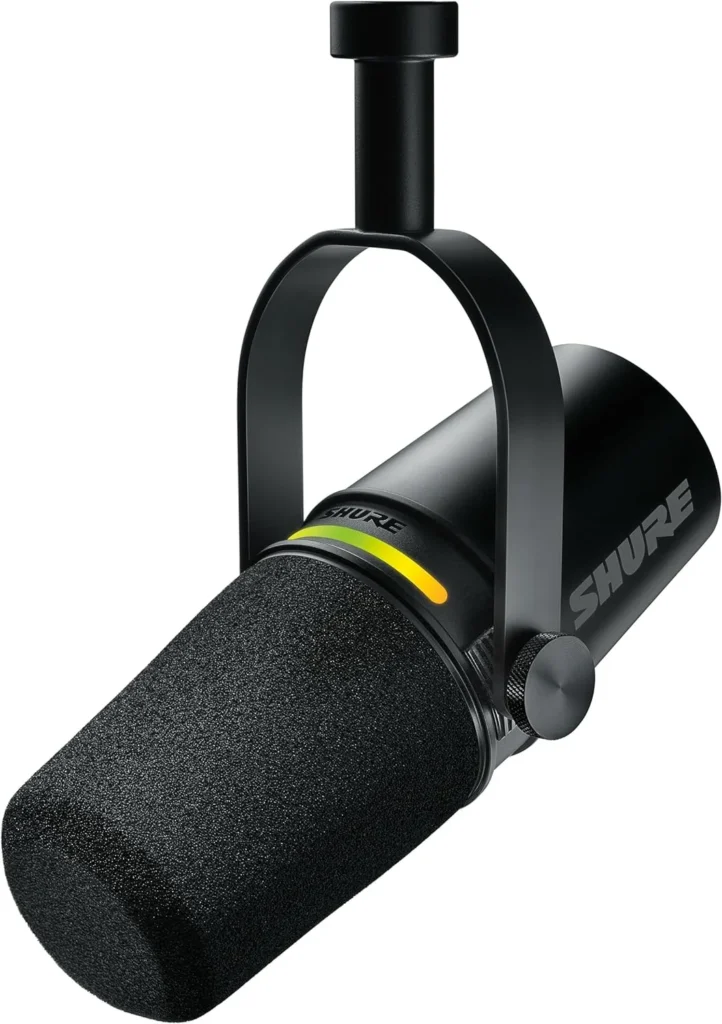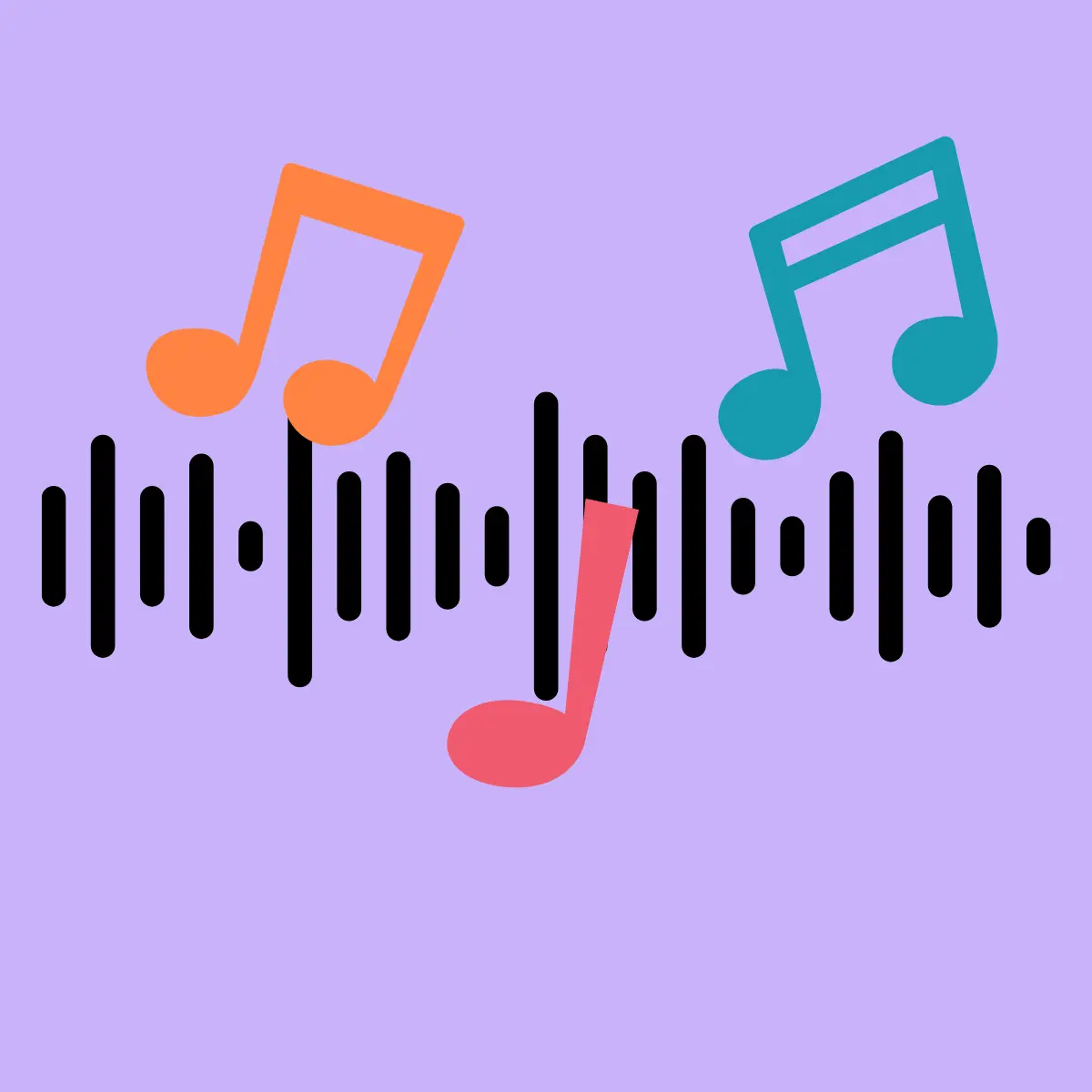How to find the right streaming microphone for you: Our 2025 recommendations for streaming microphones! + USB microphones
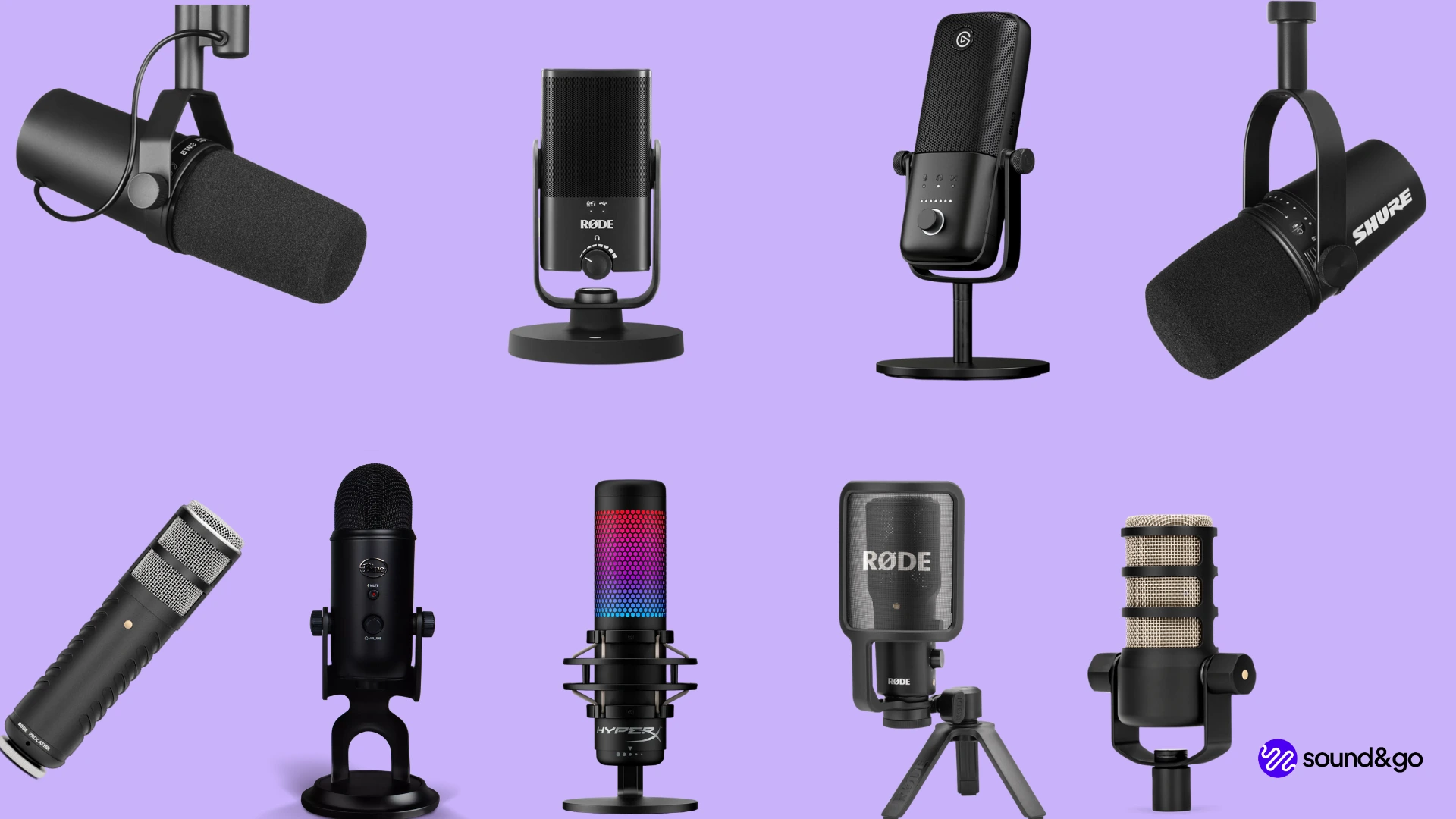
You want to start your own Twitch stream or finally want to buy a professional streaming microphone? Our comparison will help you find the perfect microphone to suit you and your voice. We also compare the different designs and connections. So you can quickly find the right streaming microphone for you.
TL;DR Our recommendations
- Use our affiliate links and support our work.
Our website is free of advertising banners and we state transparently when we have been sent a product. By purchasing from our affiliate partners you do not pay more and support us. Thank you!
The best USB streaming microphones (USB microphone)
Fifine AM8 - XLR and USB
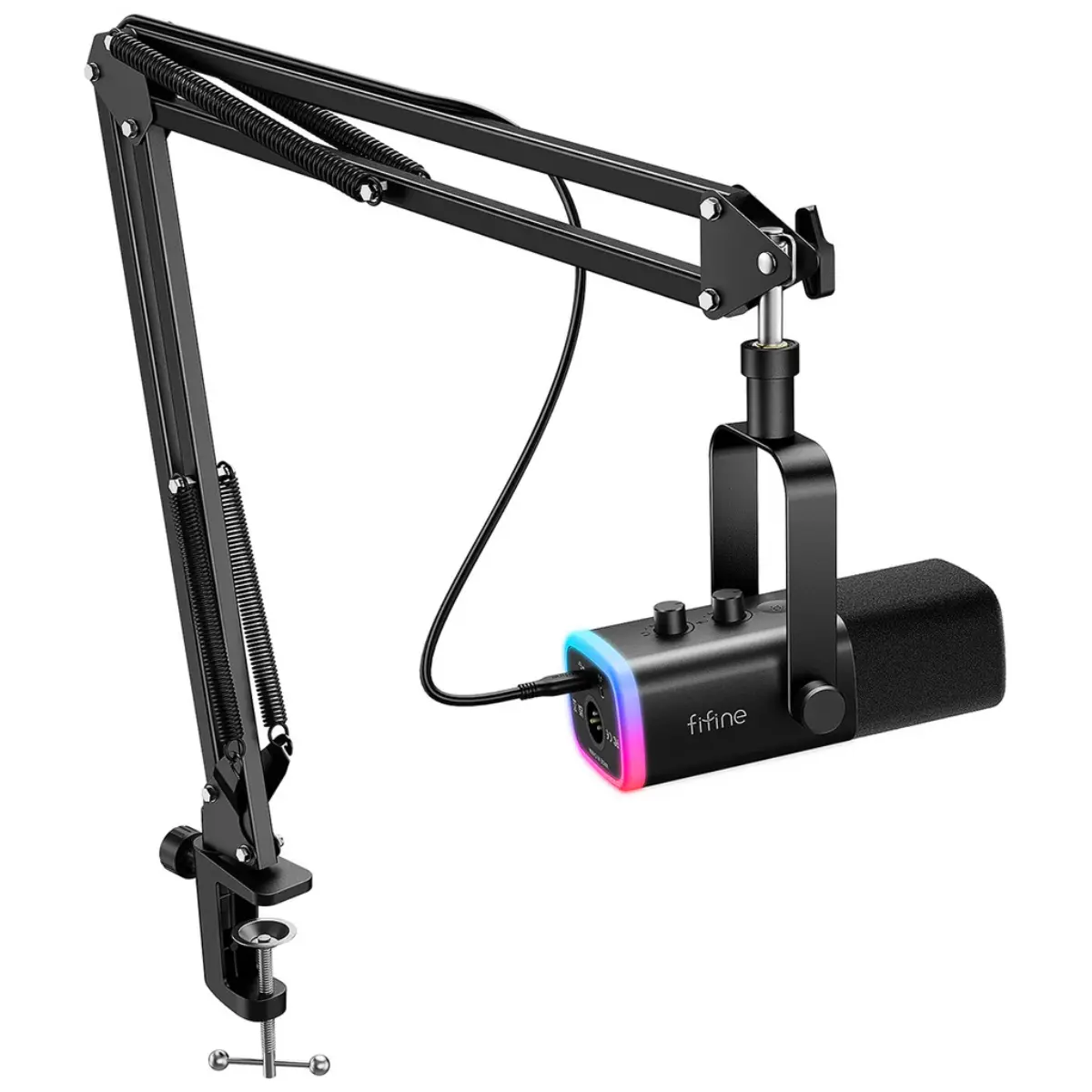
– Polar pattern: Cardioid
– Construction: Dynamic
– Entry-level model with RGB illumination
– Integrated pop protection
The first question that arises is: Is there a catch here? We have already tested several microphones and, for example, gave the Zealsound in a similar price range a completely poor rating because it was unusable in terms of sound quality. But the Fifine AM8 sounds good for its price! You can find more details in our Fifine AM8 review. For around €10 more you can get the same microphone with a microphone arm*.
The microphone is not an investment for the future, but it’s really good for occasional, non-professional use.
Elgato Wave Neo

– Polar pattern: Cardioid
– Construction: Condenser
– Entry-level model with design in the foreground
– Includes (wobbly) stand, light pop protection integrated
The relatively new Neo is primarily designed for streaming beginners and content creators. The design of the microphone is the main focus here, unfortunately at the expense of functionality. Unfortunately, the model is of inferior quality and wobbles. Further details can be found in our Elgato Wave Neo Review.
Røde NT USB Mini

– Polar pattern: Cardioid
– Construction: Condenser
– Good entry-level model with the most important functions
– Includes stand, light pop protection integrated
The affordable entry-level model in the Røde family is ideal for beginners. It has a headphone connection so you can listen to yourself and a USB connection. The “stand” for the NT USB Mini is also included. Practical! Despite the price, the sound is very pleasant and relatively low-noise for the price. The microphone has a light pop protection integrated, so if you tend to have strong P and B sounds or like to get close to the USB microphone, you should also get a pop filter. You can find out more about this model in our Rode NT USB Review.
HyperX QuadCast or QuadCast 2S

– Directional characteristic: Selectable
– Construction: Condenser
– Entry-level model with (RGB) illumination
– Includes stand and spider, additional pop protection recommended
The HyperX Quadcast is a popular model among streamers. This is mainly due to its appearance, as there is a red model* and an RGB model*. In addition to its appearance, the model records relatively cleanly, but it should be noted that there is a background noise with a relatively high volume. In addition, the Quadcast cannot be operated without lighting effects (at least not without “tricks”). A test report will follow!
Elgato Wave:3

– Polar pattern: Cardioid
– Construction: Condenser
– Good entry-level model with the most important functions
– including stand, additional pop protection recommended
The Elgato Wave:3 stands for modernity with its design, sound and connection. The built-in capsule is also modern in that it sounds good and clean. In combination with the low background noise, the Wave:3 is a well-suited microphone for streaming. There is also a suitable pop filter that can simply be placed over the microphone. According to the manufacturer’s website, a filter that reduces pop and plop noises is already built into the microphone, but this is not enough. The model is plug and play as usual, so you can start your twitch stream straight away. More details can be found in the Elgato Wave:3 review.
Røde NT-USB Plus

– Polar pattern: Cardioid polar pattern
– Construction: Condenser
– Good entry-level model with the most important functions
– Includes pop protection and stand
– NT-USB+ as the next generation
Røde is often one step ahead in terms of price-performance ratio. This model is also worth a closer look. Thanks to the controls and the headphone connection on the microphone, you can easily hear yourself and check the sound of your audio track directly during recording. It is particularly practical that the microphone package already includes a pop filter, as well as the small holder, which also functions as a lightweight bumper. A really simple plug and play solution to get your Twitch stream up and running quickly! This microphone is attractive for beginners, but can also make you very happy in the medium term. The microphone is available with holder and pop filter for around 150€. You can find out more about this model in our Rode NT USB review.
Shure MV6

– Polar pattern: Cardioid polar pattern
– Construction: Condenser
– As a Shure entry-level model in order – Including pop protection, tripod included
– Not so good in terms of sound
Even if the Shure MV6 USB gaming microphone is marketed as just that, you shouldn’t be fooled. The microphone can also be used as a streaming microphone. With the Auto Level Mode in particular, you can be sure that the level is not too loud or too quiet. This makes setup much easier. Despite the otherwise good Shure quality, the sound quality is not optimal – there are better microphones in this price range. More in the Shure MV6 review.
Rode PodMic USB: XLR and USB

– Polar pattern: Cardioid polar pattern
– Construction: Dynamic
– Good long-term model with practical additional functions
– Integrated pop protection, microphone boom arm required
– You can use this microphone with both XLR and USB-C connection!
– Software with recording function, simple settings and advanced tools such as EQ, compressor, limiter, etc.
The Australian manufacturer has sent a competitor into the ring, and it has to be said: this microphone has great potential to beat the Shure! With a lower price and similar sound characteristics, it is even slightly ahead. Another big advantage here is that it can be connected via USB as well as XLR. iPad and Android devices are also supported here. The Rode smartphone app also makes mobile recording super easy.
You can also connect your streaming headphones directly to this microphone to check the recording quality. A pop filter is included in the scope of delivery, which also works great. With the Rode software you can start recordings, make EQ settings and much more. The best thing is: there are two modes: for beginners there are 3 buttons with which you can change the sound characteristics, and for advanced users there are advanced settings in which you can adjust the EQ and compressor yourself as usual.
We have made a detailed test and a YouTube video about this microphone: PodMic USB Review.
Note: Only the linked PodMic USB has USB and XLR connection. The normal PodMic is cheaper, but has no USB connection. More on this below under XLR microphones.
Shure MV 7 Plus XLR and USB!

– Polar pattern: Cardioid
– Construction: Dynamic
– Good long-term model with practical additional functions
– Integrated pop protection, in the recommended podcast kit including stand
– You can use this microphone with both XLR and USB connection
– Software tool for EQ, compressor during recording
Das Shure MV7 Plus ist eine zweite Generation des Shure MV7. Wir empfehlen auf jeden Fall die zweite Generation. Wir haben das alte MV7 getestet, die Plus Version hat eine schönere LED anzeige und kleinere Software Features. Es ist somit intuitiver zu bedienen. Wir haben einen Ausführlichen Test und ein YouTube Video über dieses Mikrofon gemacht: Shure MV7 Test
Es gibt auch das günstigere Shure MV6*, falls dir Shure wichtig ist für 150€. Dieses würden wir für den Preis allerdings nicht empfehlen. Es gibt Mikrofone in der Preisklasse, die besser klingen.
The Shure MV7 Plus is a second generation of the Shure MV7. We definitely recommend the second generation. We have tested the old MV7, the Plus version has a nicer LED display and smaller software features. It is therefore more intuitive to use. We have made a detailed test and a YouTube video about this microphone: Shure MV7 Review.
There is also the cheaper Shure MV6*, if Shure is important to you for 150$. However, we would not recommend this for the price. There are microphones in this price range that sound better.
The best XLR streaming microphones (XLR microphone)
Note: Only the linked MV7 Plus has USB and XLR connection. The Shure MV7X is cheaper, but has no USB connection.
Elgato Wave DX

– Polar pattern: Cardioid
– Construction: Dynamic
– good alternative to the expensive SM7B
– Integrated pop filter, tripod required
The Wave DX is Elgato’s streamer microphone and does its job really well. In a direct price comparison with the Shure SM7B, the Elgato Wave DX is significantly cheaper with the same range of functions, namely a third of the price. The workmanship is robust and the simple design makes the microphone look good in any setup. The Wave DX is ideal for professional recordings, but also for simple voice chats in gaming. With its cardioid polar pattern, it manages to block out background noise well. In our opinion, a clear recommendation to buy. You can find out more in our individual article: Elgato Wave DX review.
Røde PodMic

– Polar pattern: Cardioid
– Construction: Dynamic
– Good entry-level model
– Built-in pop filter, tripod required (well suited for microphone boom)
The Røde PodMic is not only available as a USB version, but also with an XLR connection. It sounds like the PodMic USB and is a lot cheaper, as Røde logically saves on the integrated interface for this model. So if you have a USB audio interface, you can save costs and fall back on the PodMic.
Shure SM7B

– Polar pattern: Cardioid
– Construction: Dynamic
– Good long-term investment
– Pop protection not necessary, tripod absolutely necessary
– Legendary microphone for voice recordings
As already mentioned with the MV7, the Shure SM7B is probably the most legendary radio and voice microphone. It provides the typical muffled sound that makes both female and male voices sound more powerful. It sounds very pleasant, as the treble is not exaggerated. In addition, the foam on the microphone also provides pop protection and the microphone has a high-quality, robust construction. It’s not for nothing that you see this microphone in many popular streams. It is simply the classic for dynamic microphones and offers excellent sound quality.
However, you will need a stand or microphone boom. This includes the SM7B, an XLR cable, a microphone boom (stand) and smaller accessories. Note that you will also need an interface. However, once you have all this equipment together, there is almost nothing standing in the way of an absolutely professional sound. A few settings in post-production and off to the Twitch charts! You can find more information in our Shure SM7B Review.
Is there THE perfect streaming microphone?
Even though there are several YouTube videos on this topic that promise to show you THE perfect microphone for streaming, there is no single solution. Because everyone sounds different. Every person has a different voice, a different timbre and speaks differently into the microphone. The use of the microphone is also decisive for the audio quality, because if you speak extremely close into the microphone, you have a “proximity effect”, which makes the voice sound bassier. If you already have a dark voice and a microphone that cuts the low frequencies more clearly, this may be too much of a good thing.
Some people want an easy-to-use USB microphone without buttons, others want monitoring, i.e. a headphone output and a gain control. When streaming, however, we do not recommend always playing around with the gain control. Once you have found a setting that suits you, you should stick with it.
Others want an RGB microphone and would rather do without quality. Still others prefer to use a streaming headset.
XLR or USB microphone? The connections explained

The most common ways to connect your future microphone to your PC, Mac or recorder are USB and XLR cables. But which cables are best?
Basically, there are no major differences in terms of quality. USB microphones have come a long way in recent years. So there is no reason not to choose one. USB solutions are often much cheaper compared to the additional purchases you have to make if you buy an XLR microphone. This is because, logically, you can plug the USB microphone directly into the computer, whereas with an XLR microphone you need a so-called audio interface. This interface is then usually also connected to the PC via USB.
What exactly is the difference between USB and XLR microphones? While XLR microphones output the signal in analog form, USB microphones already have an analog-to-digital converter (A/D converter) built in. This converter can take over the job of the audio interface. In the past, the small A/D converters were usually of inferior quality, as the A/D converters were poor compared to those built into interfaces. This was mainly due to their size.
Cardioid or omnidirectional? Polar pattern
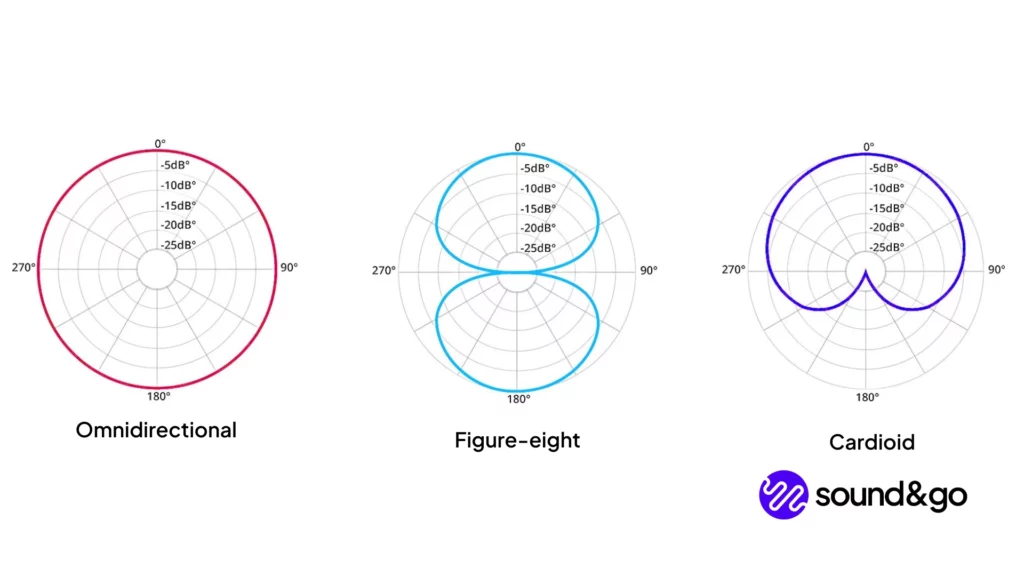
This illustration explains the directional characteristic/polar patterns relatively quickly. At 0 degrees, the microphone is picked up from the front. With the omnidirectional polar pattern, the microphone can also pick up sound from behind without loss. So if you are recording a podcast with two people, you love each other and you like to be talked to, it would be enough to buy a good omnidirectional microphone for two people. The room you are in should also be quiet.
The best directional characteristic for a classic streamer is cardioid. It is directed in such a way that the sound is not picked up from behind. This means you can speak into the microphone from the front and very little is picked up from the back. This is also practical if you are recording a podcast with two people and later cut out or shorten some parts. As each person has their own microphone, it is easier to make an edit. You have two isolated tracks, because if you are sitting opposite each other, the other person is behind your microphone in the “sound shadow”.
The figure-eight polar pattern can be used for two podcasters, as in the omnidirectional example. However, we do not recommend this. There are other polar patterns that we have omitted for the time being. The supercardioid and hypercardioid are useful in louder situations, as they are even more directional. These are used for professional street interviews, for example. The most directional characteristic is the so-called ultra directional.
Condenser microphone or dynamic? What type of microphone is suitable?
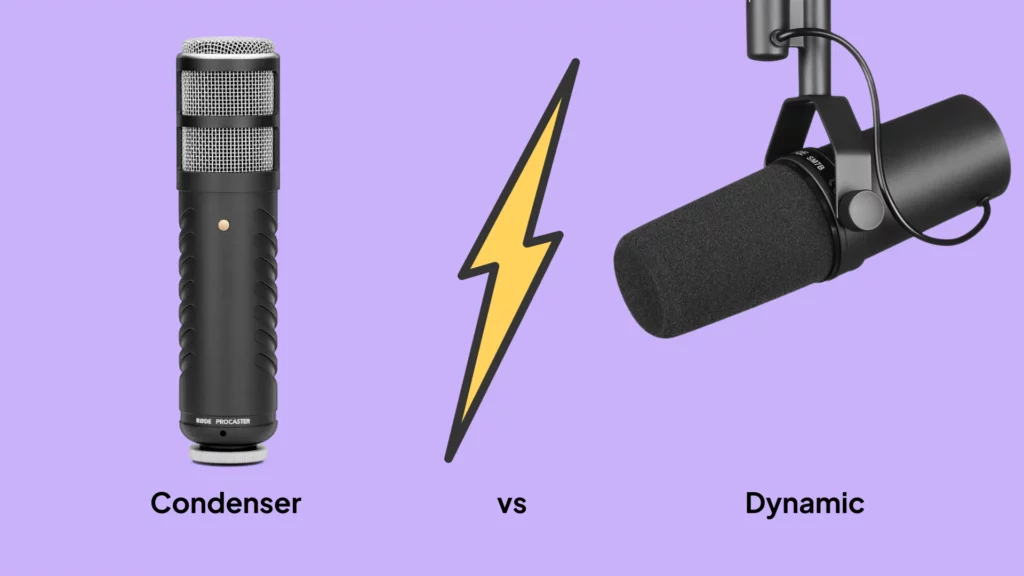
There are different types of microphones that you don’t always recognize from the outside: Dynamic, condenser and ribbon. Dynamic microphones generally sound somewhat muffled and the treble is not reproduced very accurately for physical reasons. For this reason, these microphones are used for drum recordings, for example. The condenser microphone sounds very detailed, “crisp” and “clear” in the treble. This is why it is also used for vocal and guitar recordings. The sensitivity is also somewhat higher. Ribbon microphones are rare and very expensive. For this reason, we will ignore them in this article.
Attention: Myth! Just because dynamic microphones are less sensitive in the treble range doesn’t mean that they pick up less ambient noise! They feel a little less because they have less treble, but your voice will also have less treble. If you adjust the treble, you will get almost the same result. Only the directional characteristic influences the ambient noise!
If you want the typical radio voice that sounds a bit muffled, use a dynamic microphone. If you are a big fan of treble and want to sound crystal clear, use condenser microphones. Both designs are great for your podcast, because it all depends on your voice. There is no one best microphone that fits every voice.
For nerds and interested parties: How exactly does the design differ?
The condenser microphone uses a diaphragm to pick up the sound, which begins to vibrate and thus enables the sound to be converted into electrical signals. This diaphragm is very small and sensitive, which is why this type of microphone is not well suited for very loud sound.
The dynamic microphone, on the other hand, uses a moving coil to convert the sound into electrical signals. This moving coil does not vibrate as sensitively as the diaphragm, and the sound usually has to be amplified more (by the volume control). It is therefore more suitable for loud signals. As the high frequencies have less energy, they cause the voice coil to vibrate less, resulting in a slightly muffled sound.
Accessories: Use a tripod and a pop filter

Some podcast and streaming microphones already have a stand or an integrated pop shield, but not all of them. You should definitely have both to make sure you get the best out of your voice. This is because the stand ensures that background noise is minimized. This noise occurs when you hold the microphone in your hand all the time (it’s not designed for this) or, for example, when you move around the table and it’s not properly cushioned. Most manufacturers have stands for their microphones that you can quickly find. A typical, inexpensive and functional pop protection is the Fun Generation Pop 1 for around $10. A more subtle alternative is the t.bone MS60. Please pay attention to the compatibility here.
If you want to have a studio-like situation, then a microphone arm can be worthwhile. It is super flexible, looks professional and absorbs unwanted sound from the table. However, these arms also cost a little more and are not always super easy to set up. Another professional solution is the so-called spider. This allows you to compensate for any contact and movement from the stand or table, as the microphone is only attached to elastic straps. In the picture above you can see an example from Røde.
FAQ
Why are the prices indicated approximately/not up to date?
There are new offers and price changes every day. Since we want to focus on improving your sound, we give you an overview with the price information, but not an exact, daily updated number, as this would be too much effort.
Do you use affiliate Links?
Yes, we currently use affiliate links. These are marked with the * symbol. The products are still 100% honestly reviewed by us and you will receive a partial discount. We will not recommend products just because we can earn more money from them. In the same way, we won’t skip a recommendation because you can’t find it with an affiliate partner. If you want to support us, have a look at our online course, there is a lot of helpful content and there are handouts that you can use as a cheat sheet for years. For product categories, we refer to Thomann, not because we are supported by them, but because Thomann is the most popular portal in this area.
What’s the best streaming microphone?
The best streaming microphone is the Shure SM7B*. At least, judging by its popularity. Other good and cheaper recommendations are the Røde NT USB*, and the Shure MV7* as a higher-quality recommendation.
Which microphone do most streamers use?
The Shure SM7B* is by far the most used microphone. It can be recognized by almost all professional streamers and therefore deserves the title “Most used streamer microphone”
How much does a good microphone cost?
For a good microphone that lasts a long time and sounds good, you should invest at least $100. More professional microphones cost up to $400 and more.
My microphone is noisy, how can I prevent this?
Take a look at our article: Removing Background Noise from Microphones – where we look at how you can prevent and remove static and other background noise!
Conclusion: The best microphone for streamers and gaming
Since you can usually see the microphone directly when streaming on Twitch, if you want to make a professional impression, you should go for a higher-quality version. It doesn’t have to be the Shure SM7B*, but our recommendation is the PodMic USB* or the Shure MV7*. With these models, you can get started immediately via USB connection and are well equipped for more than just streaming. For pure gamers, however, these microphones would be a little overkill. Check our blog article: The best gaming microphones.

Links marked with * are affiliate links. There are no additional costs for you, some of these links are with an automatic discount for you. We mark these links for transparency and would never recommend bad products. Find out more here: Our partners.

